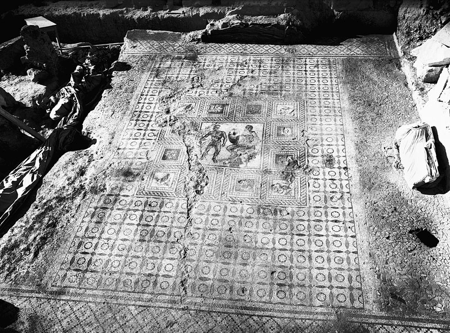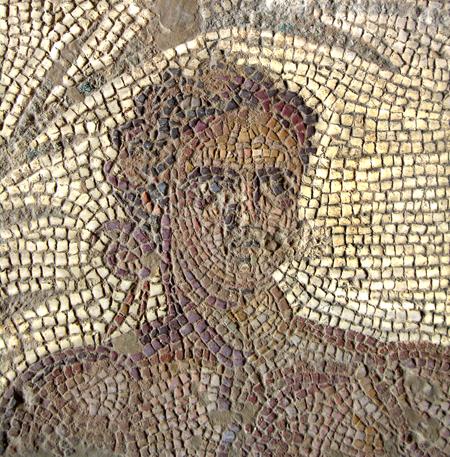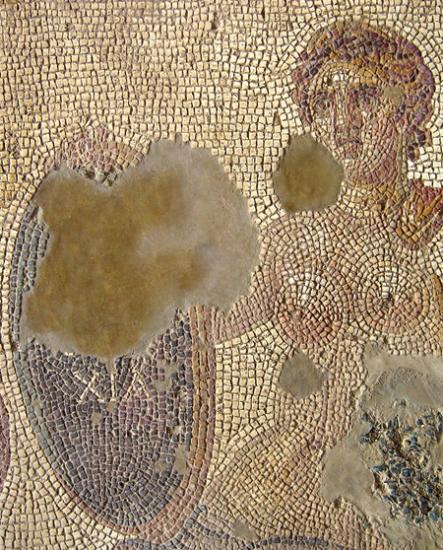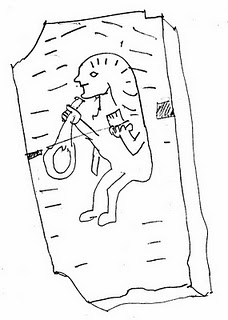It was a pleasure to see another Corinthian article in this month’s American Journal of Archaeology. Betsey Robinson’s study of the Eutychia mosaicfrom Corinth introduces us to this frequently overlooked mosaic and another pair of Corinthian bodies.

Fig. 2 (p. 106) Room C of the South Stoa at Corinth, viewed from the north, showing robbed eastern wall, mosaic, and marble-revetted bench against southern wall.
The mosaic stood in a room in the Hellenistic South Stoa, but the mosaic dates to the 2nd century. Robinson walks us through the iconography of this mosaic which shows a half-nude seated female with a shield inscribed with the word Eutychia (or fortune) and a nude youth with a victory crown. The central panel is surrounded by corner panels featuring various birds. The mosaic has been traditional associated with the administrator of the Isthmian games (the agonothetes).

Fig. 1. Eutychia mosaic, detail of athlete (N. Anastasatou and B. Robinson; courtesy American School of Classical Studies, Corinth Excavations).
Robison suggests that this mosaic should be understood as a personification of Corinth and the youth should be associated with the Isthmian games. She is careful, however, to articulate the way in which viewers would have come to these interpretations. Her analysis did not derive from a detached scholarly view of typology, but a careful consideration of ancient ways of seeing and producing art. This grounding in ancient ways of seeing opened the door to significant ambivalence in how ancient viewers might have understood this mosaic. Rather than being a liability, she suggests that such ambivalent relationships with ancient iconography are the inevitable products of the Greek – Roman hybridization that occurred in the provinces. All in all, this is a very clever and subtle reading of a neglected mosaic.

Fig. 2. Eutychia mosaic, detail of female figure and her shield (N. Anastasatou and B. Robinson; courtesy American School of Classical Studies, Corinth Excavations).
By connecting events, cities, and places to bodies, I couldn’t help but think about some of Kostis Kourelis’ recent posts which find parallels between the Byzantine water altar at the site of the former Asclepeion in Athens and an etching on an architectural discovered at the site (see here and here. The architectural fragment depicted an individual drinking from a flagon and showed the interior of the vessel flowing into the distended belly of the drinker. Here’s Kostis’ sketch of the etching:

The etching of the drinker conceptualizes the experience of the water altar in distinctly in human terms and space. The prevalence of the body as a spatial metaphor for all kinds of ancient buildings, events, places, and features makes it unsurprising to find water features paralleled with the body. All the same, Kostis’ timely post presents a nice parallel as Robinson suggests that the bodily metaphor for Corinth might evoke the personification of Peirene fountain which is sometimes also associated with the Isthmian games (other Panhellenic games have fountains associated with them). Perhaps the appearance of springs with their gaping caverns or the flow of fluid within made them particularly suitable for personifications. Or maybe the association of springs with the nymphs who frolic in their grottos.
Robinson identified the birds around the central panel as “conventional ‘hospitality gifts’ ” (p. 107). These birds may remind the view that the mosaic itself was a gift and perhaps related to the liturgies associated with the Isthmian games. Various birds are relatively common in Early Christian mosaics across the Eastern Mediterranean and it got me wondering whether the birds that appear in this context draw are likewise to draw a parallel between hospitality gifts and acts of munificence to the church.
The other thing that was interesting was that the mosaic was repaired in Late Antiquity. That suggested that the mosaic remained visible for hundreds of years. It is interesting that Robinson was willing to entertain a certain amount of ambiguity in how “contemporary” viewers saw the mosaic, but it is more challenging to understand the “contemporary view” of a mosaic that lasted at least two hundred years. The article, in general, lacked a clear since of “now” for the viewer. My guess is the late antique viewers who chose to renovate the mosaic had different goals in mind, interpretative lenses and local contexts from viewers contemporary with the mosaics original construction.